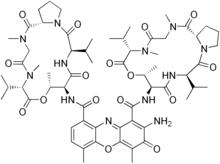닥티노마이신

| |

| |
| 체계적 명칭 (IUPAC 명명법) | |
|---|---|
| 2-아미노-N,N′- 비스[(6S,9R,10S,13R,18aS)-6,13-다이아이소프로필-2,5,9-트라이메틸-1,4,7,11,14-펜타옥소헥사데카하이드로-1H-피롤로[2,1-i][1,4,7,10,13]옥사테트라아자사이클로헥사데신-10-일]-4,6-다이메틸-3-옥소-3H-페녹사진-1,9-다이카복사마이드 | |
| 식별 정보 | |
| CAS 등록번호 | 50-76-0 |
| ATC 코드 | L01DA01 |
| PubChem | 2019 |
| 드러그뱅크 | DB00970 |
| ChemSpider | 10482167 |
| 화학적 성질 | |
| 화학식 | C62H86N12O16 |
| 분자량 | 1255.438g/mol |
| SMILES | eMolecules & PubChem |
| 약동학 정보 | |
| 생체적합성 | ? |
| 단백질 결합 | 5% |
| 동등생물의약품 | ? |
| 약물 대사 | 간 |
| 생물학적 반감기 | 36시간 |
| 배출 | ? |
| 처방 주의사항 | |
| 임부투여안전성 | D(오스트레일리아) D(미국) |
| 법적 상태 | |
| 투여 방법 | 정맥 주사 |
닥티노마이신(dactinomycin) 또는 악티노마이신 D(actinomycin D)는 여러 종류의 암을 치료하는 데 사용되는 화학요법 약물이다. 치료 질병에는 빌름스 종양, 횡문근육종, 유잉육종, 영양막 신생물, 고환암이 있다. 정맥 주사로 투여된다. RNA 합성을 저해함으로써 작용하는 것으로 추정된다.
1964년에 미국에서 사용이 승인되었다.[1] WHO 필수 의약품 목록에 기재되어 있다.[2]
의학적 사용[편집]
VAC (빈크리스틴, 닥티노마이신, 시클로포스파미드) 화학요법은 횡문근육종 치료에 사용된다.[3] 또한 치사량에 가까운 방사선 손상의 회복을 억제하고 보상과다형성을 지연시켜 방사선민감물질로 사용된다.[4]
작용 기전[편집]
DNA에 결합해 RNA 사슬이 RNA 중합효소에 의해 신장하는 것을 방해함으로써 RNA 합성을 억제한다.[5]
부작용[편집]
일반적인 부작용으로 골수 억제, 구토, 탈모, 간염, 감염, 근육통이 있다. 다른 심각한 부작용으로 암 유발, 과민증, 혈관외유출 시 조직 손상이 있다. 임신 중에 사용하면 아기에게 해를 끼칠 수 있다.[6]
역사[편집]
셀먼 왁스먼은 1940년에 스트렙토마이세스 안티비오티커스 배양물에서 악티노마이신을 발견했다.[7]
생합성[편집]

각주[편집]
- ↑ 〈Dactinomycin〉. 《LiverTox: Clinical and Research Information on Drug-Induced Liver Injury [Internet]》. National Institute of Diabetes and Digestive and Kidney Diseases. 2012. PMID 31644085.
- ↑ 세계보건기구 (2023). 《The selection and use of essential medicines 2023: web annex A: World Health Organization model list of essential medicines: 23rd list (2023)》. 세계보건기구. hdl:10665/371090.
- ↑ Arndt CA, Stoner JA, Hawkins DS, Rodeberg DA, Hayes-Jordan AA, Paidas CN, 외. (2009). “Vincristine, Actinomycin, and Cyclophosphamide Compared With Vincristine, Actinomycin, and Cyclophosphamide Alternating With Vincristine, Topotecan, and Cyclophosphamide for Intermediate-Risk Rhabdomyosarcoma: Children's Oncology Group Study D9803”. 《J Clin Oncol》 27 (31): 5182–5188. doi:10.1200/JCO.2009.22.3768. PMID 19770373.
- ↑ Hagemann RF, Concannon JP (1973). “Mechanism of intestinal radiosensitization by actinomycin D”. 《The British Journal of Radiology》 46 (544): 302–308. doi:10.1259/0007-1285-46-544-302. PMID 4720744.
- ↑ Sobell HM (1985). “Actinomycin and DNA transcription”. 《Proceedings of the National Academy of Sciences of the United States of America》 82 (16): 5328–5331. Bibcode:1985PNAS...82.5328S. doi:10.1073/pnas.82.16.5328. PMC 390561. PMID 2410919.
- ↑ American Society of Health-System Pharmacists. “Dactinomycin”. 《Drugs.com》.
- ↑ Hollstein U (1974). “Actinomycin. Chemistry and mechanism of action”. 《Chemical Reviews》 74 (6): 625–652. doi:10.1021/cr60292a002.
- ↑ Sivak A, Katz E (1962). “Biosynthesis of the actinomycin chromophore. Influence of alpha-, 4-, 5-, and 6-methyl-DL-tryptophan on actinomycin synthesis”. 《Biochimica et Biophysica Acta》 62 (1): 80–90. doi:10.1016/0006-3002(62)90493-6. PMID 13913519.
- ↑ Keller U, Lang M, Crnovcic I, Pfennig F, Schauwecker F (2010). “The actinomycin biosynthetic gene cluster of Streptomyces chrysomallus: a genetic hall of mirrors for synthesis of a molecule with mirror symmetry”. 《Journal of Bacteriology》 192 (10): 2583–2595. doi:10.1128/JB.01526-09. PMC 2863554. PMID 20304989.
